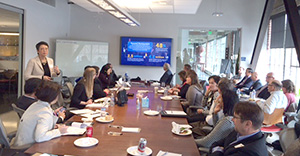
(Photo: Judit Klein/Flickr)
Near the California state capitol, inside a hip work loft — a one-time car dealership that’s been up-scaled to a professional office —community and business leaders came together this week to talk about the future of work – the dynamic, fascinating and at times unsettling future of work.
“The economy is unforgiving to those without skills,” said Van Ton-Quinlivan, executive vice chancellor at the California Community Colleges. “The rules of the labor market have changed.”
Many of the participants at the Future of Work MeetUp event have one foot in “the building” where state policies and budgets influence the fates of 40 million Californians, and one foot in their community – as employers and HR professionals, school board members and civic entrepreneurs, parents and adult children with still-working parents.
The agenda for the MeetUp was to review what California community colleges are doing to help students, workers and employers prosper now and to explore what else should be done so that today’s “stranded workers” can earn a living wage and more Californians don’t become stranded as global markets and technologies disrupt businesses and industries.
 Ton-Quinlivan explained that the state’s Doing What Matters for Jobs and the Economy and the Strong Workforce programs were designed to “change the ecosystem” so colleges better serve evolving regional economies. That ecosystem is increasingly dependent on true partnerships between the state and regions, and among colleges and employers within the regions.
Ton-Quinlivan explained that the state’s Doing What Matters for Jobs and the Economy and the Strong Workforce programs were designed to “change the ecosystem” so colleges better serve evolving regional economies. That ecosystem is increasingly dependent on true partnerships between the state and regions, and among colleges and employers within the regions.
Kish Rajan said the Center for Competitive Workforce in Los Angeles is an example of a partnership formed by the Los Angeles Economic Development Corporation and colleges in the region to develop detailed supply-and-demand models and relevant educational programs for important sectors in the region, such as digital media entertainment. Rajan, who formally directed the Governor’s Office of Business and Economic Development, said such partnerships are essential to reducing poverty and preparing the state for significant changes in markets and industries.
Within the Sacramento region, Valley Vision is gathering qualitative information from employers to construct and improve public-private partnerships, said Valley Vision Managing Director Trish Kelly.
A representative of Dignity Health described an emerging partnership with the Los Rios Community College District in Sacramento designed to accelerate the preparation for students entering the health care field and for current employees to gain new skills and advance their careers.
Ton-Quinlivan affirmed these are the kinds of partnerships that recent state policies were designed to encourage. Some 80 percent of middle-skilled jobs require digital skills and 65 percent of jobs will require a college credential by 2020.
And they will continue to change in expected and unexpected ways. So the conversation then turned to Governor Brown’s proposal for a 115th community college – one that would operate statewide, provide education online and be designed to increase access to the 2.5 million young adult Californians with little training beyond high school.
The tech-based learning structure would teach students competencies needed for industry-valued certificates, allow students to progress as fast as they can master those competencies, and provide multiple opportunities throughout the year to begin taking classes. The college also would include significant student support and would be designed to reach Spanish-speaking adults who have not been adequately served by campus-based instruction.
Research shows that many low-skilled workers struggle to access low-cost training opportunities. Family obligations, transportation costs, jammed schedules and the time it takes to complete programs are all barriers. Many would-be students had bad experiences with schools and are intimidated by traditional colleges.
Successful online learning platforms – particularly nonprofit or publicly owned institutions – are overcoming those barriers with a variety of strategies, including personalized student support.
The new college also is expected to make it easier for employers to partner on curriculum and programs to help current workers acquire additional competencies to advance their own careers and develop the skills for emerging jobs as current jobs are replaced or morphed by new technologies.
Some 47 percent of jobs could be replaced by automation by 2020, Ton-Quinlivan said, and 45 percent of employment-related activities could be automated with existing technologies. She said government, civic and business leaders need to answer the question: “How do we ensure that workers are resilient?”
Of the business and community leaders participating in the MeetUp, 67 percent said they expected to see “noticeable disruptions” in the industries they are involved in within the next five to 10 years.
Most of the MeetUp participants expressed support for the concept of a tech-based statewide college. They also underscored the importance of college leaders diligently developing the technological infrastructure, the curriculum and programs, and the student supports needed for the new model to be successful.
The MeetUps are one part of a multi-part effort to evolve the Governor’s proposal from concept to operation, and to build into the college the data feedback loops to enable continuous improvement driven by student success in the workplace.
More information on the Governor’s proposal can be found here, and information on attending upcoming Future of Work MeetUps can be found here.

